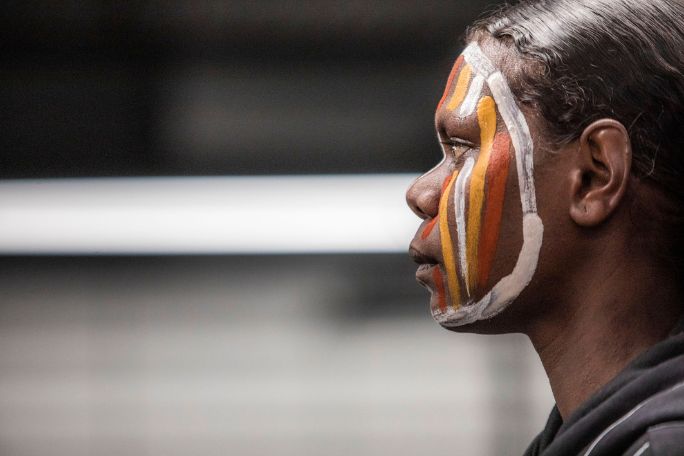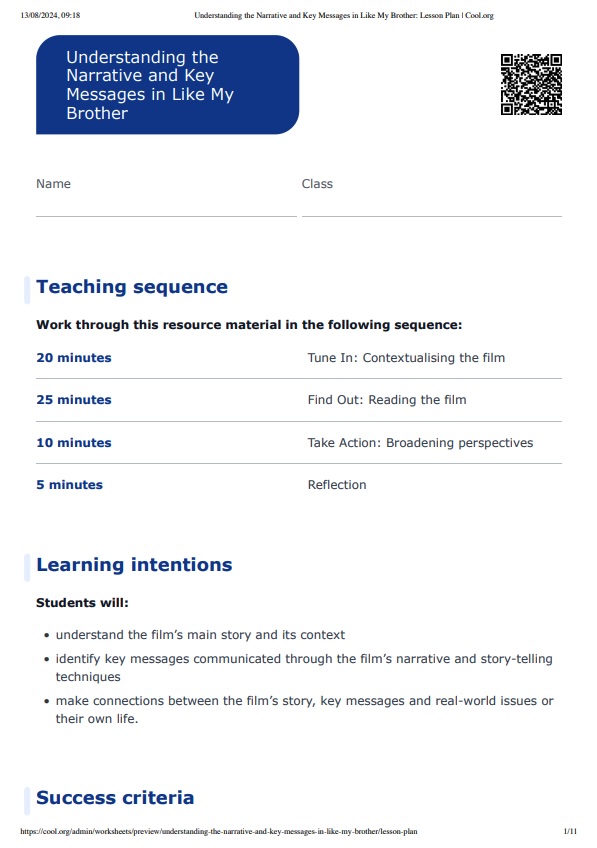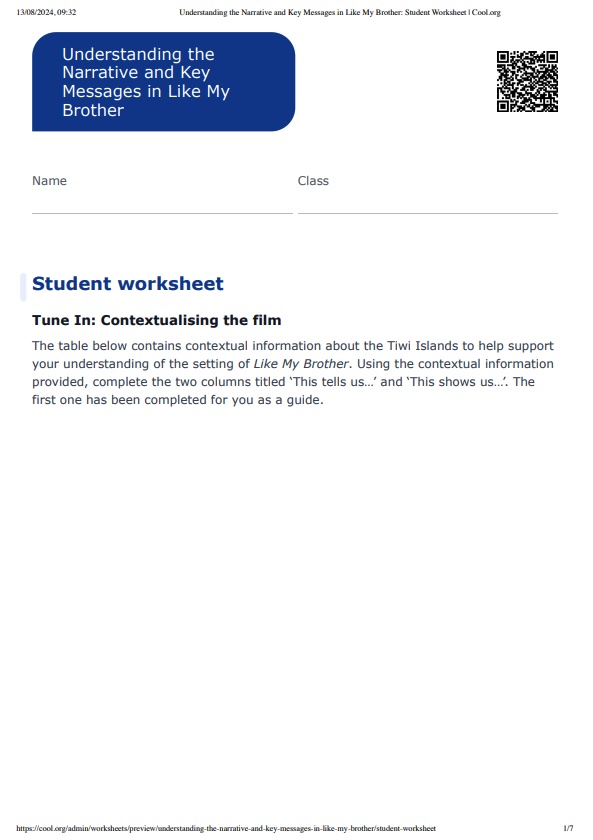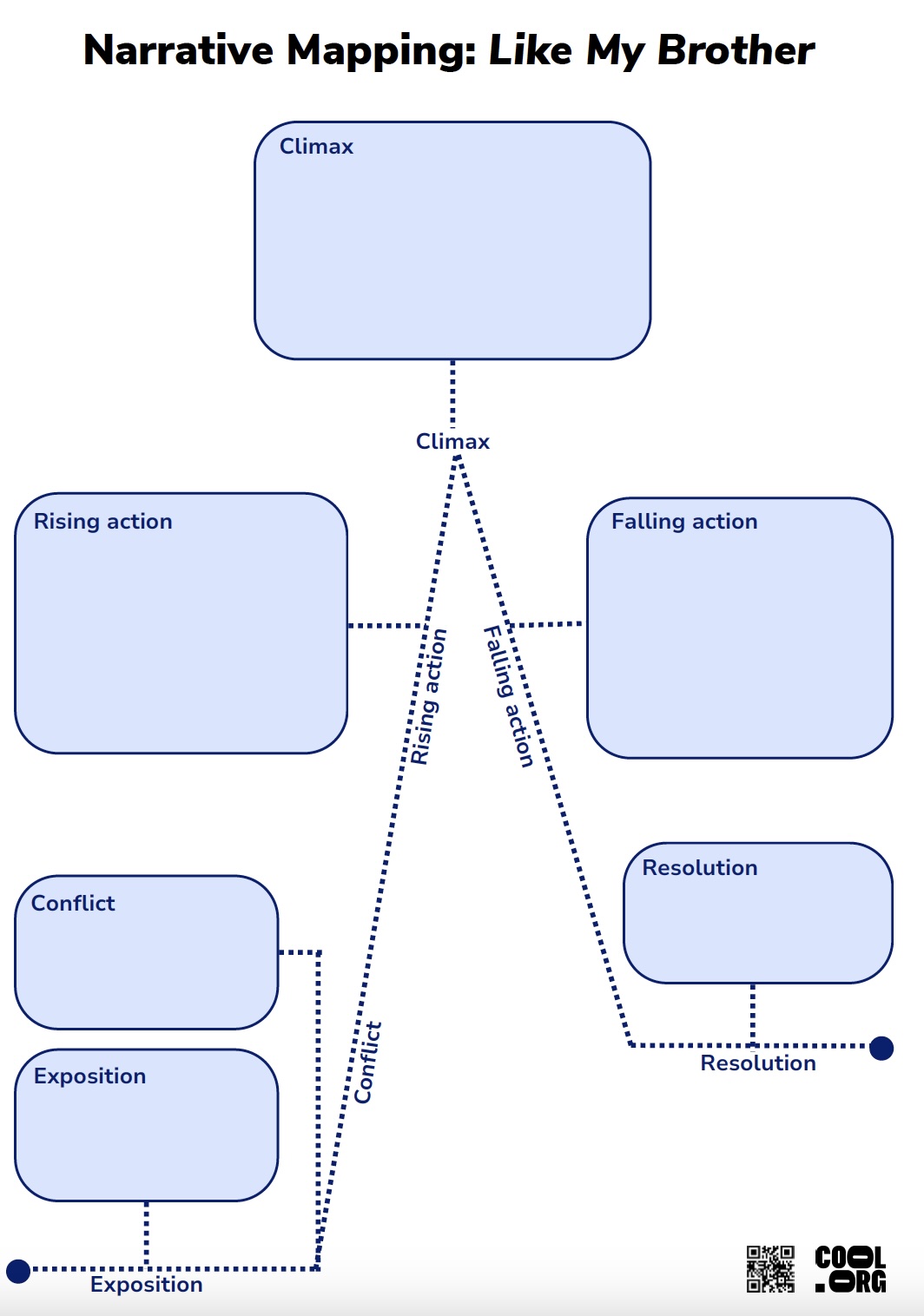Lesson summary
Students will understand Like My Brother’s narrative and context, and will describe how some of the story-telling techniques and representations communicate key messages to an audience. They will draw on these aspects of a film text to establish and reflect on their interpretation and make connections between the documentary and real-world issues or their own lives.
Learning intentions:
Students will...
- understand the film’s main story and its context
- identify key messages communicated through the film’s narrative, representations and story-telling techniques
- make connections between the film’s story, key messages and real-world issues or their own life.
Success criteria:
Students can...
- explain the film’s main story and context
- describe how the film’s narrative, representations and story-telling techniques shape key messages
- explain connections between the film’s key messages and other real-world issues or their own life.
Lesson guides and printables
Curriculum links
Select your curriculum from the options below.
Lesson details
Skills
This lesson is designed to build students’ competencies in the following skills:
- critical thinking
- communication
- cultural understanding
- curiosity
- empathy
- intercultural understanding
- reflection
Curriculum Mapping
Australian Curriculum (v9.0) content description:
Year 9 English
Students learn to
- analyse the representations of people and places in literary texts, drawn from historical, social and cultural contexts, by First Nations Australian, and wide-ranging Australian and world authors. (AC9E9LE01)
- present a personal response to a literary text comparing initial impressions and subsequent analysis of the whole text. (AC9E9LE02)
Year 10 English
Students learn to
- evaluate the features of still and moving images, and the effects of those choices on representations. (AC9E10LA07)
- analyse how the aesthetic qualities associated with text structures, language features, literary devices and visual features, and the context in which these texts are experienced, influence audience response. (AC9E10LE03)
Relevant parts of Year 9 and 10 achievement standards:
Year 9 English
Students read, view and comprehend a range of texts created to inform, influence and/or engage audiences. They analyse representations of people, places, events and concepts, and how texts respond to contexts. They analyse the aesthetic qualities of texts. They analyse the effects of text structures, and language features including literary devices, intertextual references, and multimodal features.
Year 10 English
Students read, view and comprehend a range of texts created to inform, influence and engage audiences. They analyse and evaluate representations of people, places, events and concepts, and how interpretations of these may be influenced by readers and viewers. They analyse the effects of text structures, and language features including literary devices, intertextual connections, and multimodal features, and their contribution to the aesthetic qualities of texts.
NSW Syllabus outcomes
EN5-RVL-01: uses a range of personal, creative and critical strategies to interpret complex texts.
EN5-URA-01: analyses how meaning is created through the use and interpretation of increasingly complex language forms, features and structures.
EN5-URB-01: evaluates how texts represent ideas and experiences, and how they can affirm or challenge values and attitudes.
EN5-ECB-01: uses processes of planning, monitoring, revising and reflecting to purposefully develop and refine composition of texts.
General capabilities: Critical and Creative Thinking, Intercultural Understanding, Literacy
Cross-curriculum priority: Aboriginal and Torres Strait Islander Histories and Cultures
Level of teacher scaffolding: Medium - The teacher will need to organise groups for activities, facilitate class discussions and prompt thinking.
UN Sustainable Development Goals
UN SDG 5: Achieve gender equality and empower all women and girls
- Target 5.c: Adopt and strengthen sound policies and enforceable legislation for the promotion of gender equality and the empowerment of all women and girls at all levels.
Resources Required
- Device to play and project film and film clips
- Narrative Mapping Activity
- Student Worksheet
- Whiteboard and whiteboard markers
Additional Info
Like My Brother is a Film by Sal Balharrie under her production company, Naked Emperor in partnership with Tiwi Co-Producers Tictac (Dianne) Moore, and Tammy Abala and Shane Tipuamantamerri (of Mamanta Consulting).
The Tiwi Islands are located North of Darwin, with a rich history of traditional culture and an unparalleled love of Australian Rules football.
On 3 February 2017, Sal took her son and his friends to see the very first AFLW game - Carlton versus Collingwood. The stadium at Ikon Oval was packed and the vibe was incredible; this was fresh and wonderful - a brand new opportunity for young women to play professional Aussie Rules Football! But as the crowd cheered, what Sal saw out on the field was also very, very white. Where was the spark of Indigenous play? Where was the Tiwi magic? And how would young Tiwi women make it to Melbourne? What would it take for Tiwi girls to experience ‘success’ just like their brothers?
And from this spark of an idea began a seven year project of a collaborative, creative team asking these very questions. Co-directed by Sal Balharrie and Danielle MacLean, Like My Brother takes us inside small moments of human experience to ask big questions. With a light touch, the film invites us to walk in the shoes of another; to take a moment to think about and challenge the ways in which we see the world. Using layers of filmmaking - moving images, dialogue, character, theme and, importantly, music, the film sets out to explore: what does it take to dare to dream, what are the costs, and ultimately, who defines ‘success’?
Accessing The Film
Teachers should watch Like My Brother (the trailer is here) to familiarise themselves with the narrative, themes, characters and content. School bookings to view the film can be made through:
- Event Cinemas: privatehire@evt.com
- Hoyts Cinemas: schools@hoyts.com.au
- Palace Cinemas: magenta.mchalick@palacecinemas.com.au
- Reading Cinemas: info@readingcinemas.com.au
- Village Cinemas: functions@village-cinemas.com
Related Professional Learning
Beginning to Include First Nations Peoples' Perspectives in Your Classroom
Quick Summary: This course aims to inform and upskill educators in incorporating Aboriginal and Torres Strait Islander perspectives. The course emphasises the importance of connecting with personal motivations, overcoming biases, and incorporating diverse perspectives while being inclusive of Aboriginal and Torres Strait Islander languages and cultures. Additionally, it provides guidance on terms of reference, protocols, and strategies for inclusivity, fostering an inclusive and accepting educational environment and curriculum design.





Welcome back!
Don't have an account yet?
Log in with:
Create your free Cool.org account.
Many of our resources are free, with an option to upgrade to Cool+ for premium content.
Already have an account?
Sign up with:
By signing up you accept Cool.org's Terms and Conditions(Opens in new tab) and Privacy Policy(Opens in new tab).